 AcademiaBID | Cursos online | Amplía tus habilidades y conocimiento con todos nuestros recursos de aprendizaje
AcademiaBID | Cursos online | Amplía tus habilidades y conocimiento con todos nuestros recursos de aprendizaje
Entrepreneurship
In recent years, the advent of the CRISPR/Cas9 technology has transformed the field of genetic engineering, offering unprecedented precision and efficiency in gene editing. This revolutionary tool allows researchers to modify DNA sequences within living organisms, paving the way for groundbreaking advancements in medicine, agriculture, and biotechnology. A crucial component in the application of CRISPR technology is the production of adeno-associated viruses (AAVs), which serve as delivery vehicles for Cas9 and guide RNA into target cells. This article explores the significance of CRISPR/Cas9 AAV production services in scientific research and therapeutic development.
Understanding CRISPR/Cas9 Technology
CRISPR/Cas9 works by utilizing a guide RNA that directs the Cas9 endonuclease to a specific location in the genome. Once at the target site, Cas9 creates a double-strand break in the DNA. The cell’s natural repair mechanisms then kick in, allowing for either error-prone repair that can induce gene knockouts or precise repair via homology-directed repair methods. This versatility makes CRISPR/Cas9 a powerful tool for gene editing, with applications ranging from gene therapy to synthetic biology.
The Role of AAV in Gene Editing
Adeno-associated viruses are small viruses that can efficiently deliver genetic material into host cells without causing disease. In the context of CRISPR/Cas9, AAVs are particularly valuable because they can package and transport the necessary components—Cas9 protein and guide RNA—into the target cells in a safe and effective manner. The advantages of AAVs include their ability to infect a wide range of cell types, facilitate long-term expression of the inserted genes, and generate minimal immune response, making them suitable for therapeutic applications.
Services Offered in AAV Production
AAV production services have emerged to meet the growing demand for high-quality viral vectors in research and clinical applications. These services typically encompass a range of offerings to ensure successful gene editing outcomes:
Vector Design and Construction: Tailoring AAV vectors to include specific genetic sequences based on the researcher’s requirements is a crucial first step. This involves designing the appropriate promoter elements and regulatory sequences to ensure proper expression of the delivered genes.
Viral Production: Utilizing well-optimized cell lines, production facilities generate AAVs at scale. Advanced methodologies, such as triple-transfection methods, are often employed to enhance yield and quality.
Purification and Characterization: Following production, AAVs must be purified to remove impurities and ensure high titers. Characterization techniques, such as qPCR and Western blot, are employed to verify viral particle concentration and functionality.
Quality Control: Comprehensive quality control measures are essential to confirm the safety and efficacy of the AAVs. Testing for sterility, potency, and stability helps guarantee that the vectors are suitable for experimental and therapeutic use.
Applications of CRISPR/Cas9 AAV Services
The applications of CRISPR/Cas9 AAV production services are extensive and continue to expand as technology advances. These services play a pivotal role in:
- Gene Therapy: Treating genetic disorders by delivering corrected genes to affected cells.
- Cancer Research: Developing innovative treatment strategies by targeting oncogenes or enhancing immune responses against tumors.
- Model Organisms: Creating genetically modified organisms for research to study gene function and disease mechanisms.
- Agricultural Biotechnology: Modifying crops to improve traits such as resistance to pests and environmental stress.
Conclusion
CRISPR/Cas9 AAV production services represent a vital intersection of biotechnology and medicine, providing researchers and clinicians with the tools necessary to explore gene editing’s full potential. As we continue to unlock the secrets of the genome and harness the power of CRISPR technology, these services will undoubtedly play a crucial role in advancing scientific knowledge and developing innovative therapies for various diseases. By streamlining the production and delivery of transformative genetic materials, CRISPR/Cas9 AAV production services stand at the forefront of a new era in genetic research and treatment.

